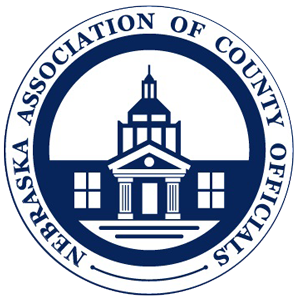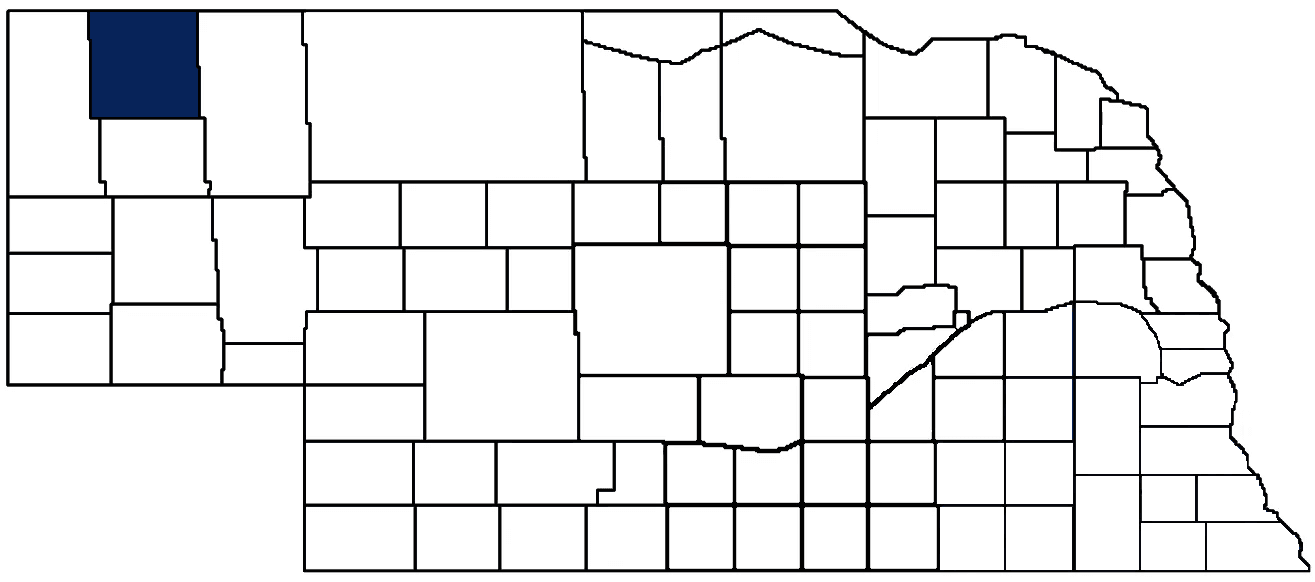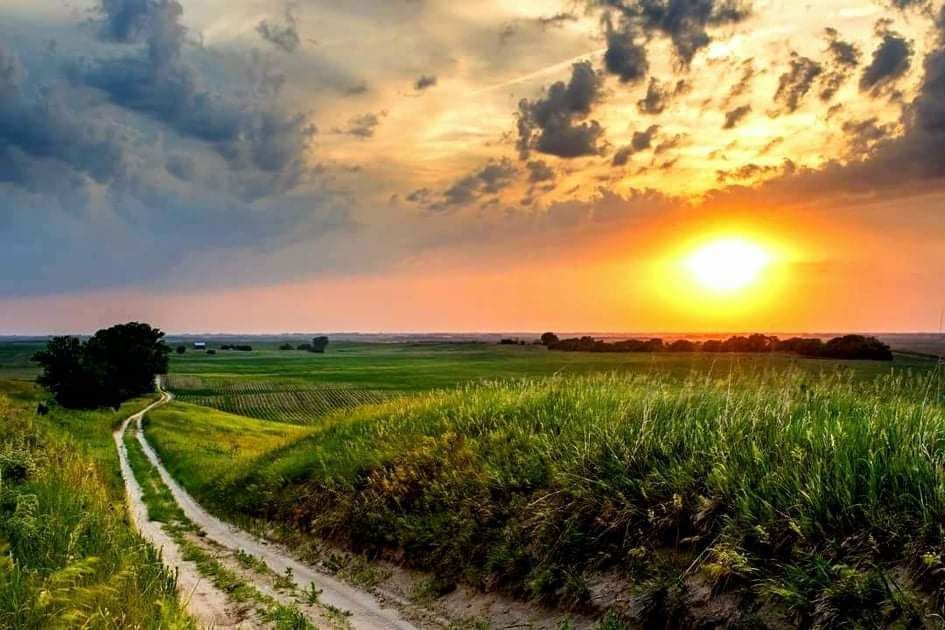- General Info
- Demographics
- Education and Employment
- Valuation and Taxes Levied
- State Senators
- History
- County Programs
- Other Information
Communities & Development
Dawes County Seat: Chadron
Total County Population: 8,199
- Cities (pop. & class): Chadron (5,206 • 1st Class), Crawford (840 • 2nd Class)
- Villages (pop.): Whitney (62)
- Unincorporated Pop. (% of county pop.): 2,091 (26%) 2020
Land Development (% of total land in county):
- Agriculture: 88%
- By method: Pasture (pure grassland) (72%); Dryland (row crop/grain/forage) (13%); Irrigated (row crop/grain/forage) (2%) • Neb. Dept. of Rev. - total equals agriculture's %
- By commodity: Livestock (grassland) 72%, Alfalfa 6%, Other Hay 3%, Wheat 2%, Corn 1%, Millet 1% • USDA - equals agriculture's % plus some fallow land (2%) and some wetlands (1%) and minus public grassland/wetlands and reserve
- Residential, Commercial, Industrial, Conservation Reserve & Exempt (combined): 12% 2022
County Offices
Courthouse Address and Hours:
451 Main Street
Chadron, Nebraska 69337
M-F 8:30 am - 4:30 pm
County Board Chairperson: Webb Johnson
Complete list of county board members
County Board Meetings: 2nd & 4th Tuesday
View the County's Government Maps
NACO District: Panhandle
General
Population: 8,199
Land area (sq. mi.): 1,396.39
Population per square mile: 5.9
Race & Age
Race 2020
White: 84.7%
African American: 2.0%
American Indian: 3.9%
Asian: 0.6%
Hispanic: 4.0%
Native Hawaiian and Pacific Islander: 0.1%
Two or More Races: 4.4%
Age 2020
0-17: 17.6%
18-64: 62.8%
65+: 19.6%
Households
Total households: 3,325 2020
With one child: 320 2022
With 2+ children: 470 2022
With seniors (65+): 840 2022
Socioeconomics
Median household income: $54,381 2023
% of Population in Poverty: 16.2% 2023
# of Housing Units: 4,002 2020
Owner-occupied rate: 63.2% 2020
Median home price: $158,470 Q4 2024
2024 building permits for detached single family homes: 17
2024 building permits for non-detached housing units: 60 (townhouse, duplex, or apt. unit)
Technology
Access to broadband (100 Mbps via fiber or cable modem): 29.9% 2021
Sources: National Association of Realtors, Nebraska Department of Revenue, Nebraska Legislature, Nebraska Library Commission, U.S. Bureau of Economic Analysis, U.S. Census Bureau (building permits), U.S. Census Bureau (demographics), U.S. Census Bureau (municipalities)
Employment, Schools, and Child Care
Unemployment rate: 2.3% March 2025
County Employment Website: https://dawes-county.com/county-offices/hr-department/
High school graduate or higher: 94.0% 2020
School Districts: Chadron Public Schools, Crawford Public Schools, Hay Springs Public Schools, Hemingford Public Schools, Sioux County Public Schools
Bachelor's degree or higher: 38.2% 2020
Community College Service Area: Western Nebraska Community College
Countywide child care capacity: 15 providers; 268 children 2024
Find child care: For a list of child care providers in your zip code, visit Nebraska DHHS or the Nebraska Resource and Referral System.
Dawes County Economy
Annual Gross Domestic Product (GDP): $366,424,000 2023
Nonfarm Small Business Receipts: $42,661,773 2023
Nonfarm Wage Income: $130,428,000 2022
Farm and Ranch Commodity Sales Receipts: $78,212,000 2022
Farm and Ranch Operations (Non-Sales) Receipts: $4,796,000 2022
- For components of nonfarm small business receipts, nonfarm wage income, and farm & ranch commodity sales and operations receipts, see "Notes" below.
Grain Elevators by Location (bushels capacity):
- Chadron: Legacy (514,000)
- (1 bushel = 56 lbs. corn/sorghum, 60 lbs. soybeans/wheat; % max. moisture = 18% beans, 15.5% corn, 14% sorghum/soybeans, 13.5% wheat)
Railroad Miles: 128.06 main, 18.99 side
- Places with Railroad Service: Belmont, Chadron, Crawford, Marsland, Whitney
Farmers Market: Crawford Farmers Market (July through September, Sundays 11:00 am- 2:00 pm)
Local Grain Market: Click for today's grain prices in Dawes County
Cattle Producers: 261
- Pastureland Cash Rent (avg.): $16/acre 2024
Crop Producers: 79
- Dryland Cash Rent (avg.): $30/acre 2024
Electricity Providers: Nebraska PPD, Niobrara Electric Association, Inc., Northwest Rural PPD
Wind Turbines Operating (MW): 1 turbine (100 MW)
Notes
- Nonfarm small business receipts are reported by partnerships and sole proprietorships. They do not include receipts reported by cooperative associations.
- Nonfarm wage income is reported based upon the wage earner's residential address; therefore, it also includes wages earned by Dawes County residents in other counties or states, but it excludes wages earned in Dawes County by residents of other counties or states.
- Nonfarm wage income excludes wages earned by anyone claimed as a dependent.
- Farm and ranch commodity sales receipts and operations receipts are reported based upon the farm or ranch owner's principal county of operations; therefore, those figures also include receipts reported by producers operating principally in Dawes County for their production in other counties or states, but the figures exclude receipts reported for production in Dawes County by producers operating principally in other counties or states.
Irrigation, Drinking Water, and Soils
Rural Irrigation/Livestock Wells: 351 2024
Rural Commercial/Industrial Wells: 7 2024
Rural Drinking Water Wells: 226 2024
Drinking Water Utility Connections: 2,240 Residential; 367 Commercial; 0 Industrial 2024
Agricultural Wells per Square Mile: 0.25 2024
Surface Water Diversions (Irrigation): 283 2024
Click for real time:
Groundwater level data on Carlson Rd. (16 mi. southeast of Chadron)
Sources: National Agricultural Statistics Service (USDA), Nebraska Cooperative Council, Nebraska Coordinating Commission for Postsecondary Education, Nebraska Department of Health and Human Services, Nebraska Department of Revenue, Nebraska Department of Transportation, Nebraska Office of the CIO, Nebraska Power Review Board, Nebraska Public Service Commission, U.S. Bureau of Economic Analysis, U.S. Bureau of Labor Statistics, U.S. Census Bureau, U.S. Energy Information Administration, U.S. Department of the Treasury (IRS), Warehouse and Commodity Management Division (USDA)
2024 Levies and Valuation
County levy rate: $0.3620 per $100 of taxable valuation
County property taxes levied: $4,361,336
Total local government property taxes levied: $18,496,046
Total countywide taxable valuation: $1,204,905,740
Federal PILT payment to Dawes County (FY2024): $205,154 regarding 63,563 federally-owned acres
Federal SRS payment to Dawes County (FY 2024): $63,563 regarding the Nebraska National Forest
Click here for all levy rates in Dawes County
County Levy and Taxation Laws
Levy limits
Since 1996, counties and other political subdivisions have been subject to the levy limits listed in Neb. Rev. Stat. § 77-3442 and Neb. Rev. Stat. § 77-3443.
Statutes and regulations
Nebraska Revised Statutes (Chapter 77)
Nebraska Administrative Code (Title 350)
Local tax reductions, exemptions, and credits:
Neb. Rev. Stat. § 76-902(5)(a) (Deed "stamp tax" exemption): "The [stamp tax] shall not apply to: ... (5)(a) Deeds between spouses, between ex-spouses for the purpose of conveying any rights to property acquired or held during the marriage, or between parent and child, without actual consideration therefor."
Neb. Rev. Stat. § 77-201(2) (Valuation of agricultural land and horticultural land): "Agricultural land and horticultural land as defined in section 77-1359 shall constitute a separate and distinct class of property for purposes of property taxation, shall be subject to taxation, unless expressly exempt from taxation, and shall be valued at seventy-five percent of its actual value, except that for school district taxes levied to pay the principal and interest on bonds that are approved by a vote of the people on or after January 1, 2022, such land shall be valued at fifty percent of its actual value."
Neb. Rev. Stat. § 77-6703(1) (Tax credit for school district taxes paid): "(1) For taxable years beginning or deemed to begin on or after January 1, 2020, under the Internal Revenue Code of 1986, as amended, there shall be allowed to each eligible taxpayer a refundable credit against the income tax imposed by the Nebraska Revenue Act of 1967 or against the franchise tax imposed by sections 77-3801 to 77-3807. The credit shall be equal to the credit percentage for the taxable year, as set by the department under subsection (2) of this section, multiplied by the amount of school district taxes paid by the eligible taxpayer during such taxable year."
Sources: Nebraska Department of Revenue
State Senator: Tanya Storer (District 43)
Committees
Map and statistics for Legislative District 43
Map of all districts in the Nebraska Unicameral Legislature
Dawes County History
Number of Registered Historic Places: 15
Year Authorized: 1885
Year Organized: 1885
Etymology: James W. Dawes (Nebraska’s 6th governor)
In the 1870s, the area that would become Dawes County was inhabited by two large divisions of the Sioux tribe: the Brules inhabited the land near the White River, while the Oglalas occupied territory just east of Fort Robinson. The lands were unsurveyed and considered by the government to be public domain, rather than the rightful lands of the Native Americans. At the time, the unwritten laws dictated that establishing a ranch entitled a man to sufficient range for his needs, including land already inhabited by indigenous tribes.
In the 1880’s, railroads began expanding their lines through the territory while the government set about surveying the area for settlement. While open range ranching dominated the landscape for years, newly arrived homesteaders also began farming grain. By the 1890’s, the cowboy era ended as frontier lands were settled and barbed wire, railroads, and farmland reduced the open range.
Dawes County was officially organized in 1885, when Sioux County was divided into Dawes and Sheridan County. The county was named for Governor James W. Dawes and was home to Fort Robinson, now a popular historical tourist attraction. A special election established Chadron as the county seat, and in 1887, county residents spent $35,000 (approximately $600,000 today) to construct a courthouse, which lasted until the present courthouse was built in 1936.
Today, Dawes County is home to Chadron State College, parts of the Nebraska National Forest, and Chadron State Park. The county is also home to many different sectors of economic development—not only the traditional sectors of farming, ranching, manufacturing, and tourism, but also uranium mining.
Highlight an important program in your county in this space! Send an email to:
Local Highlights
License Plate Number: 69
Time Zone: Mountain
Number of Veterans: 586 2023
Zoned County: Yes
Number of County-Owned Bridges: 48
Number of County-Owned Dams: 1
Election Data
General Election Turnout: 78% 2024
Total Registered Voters: 5,076 2024
Number of Precincts: 11 2022
Number of Election Day Polling Places: All Voting by Mail
Intergovernmental Data
Emergency Mgt. Planning, Exercise and Training (PET) Region: Panhandle
Natural Resource District: Upper Republican NRD
State Lands (acres): Bighorn WMA (1,270.65), Bordeaux WMA, Box Butte Reservoir WMA (1,955), Chadron Creek Ranch WMA (2,529), Chadron State College (281), Chadron State Park (974.26), Fort Robinson State Park (22,332.72 Sioux & Dawes), Ponderosa WMA (4,831)
Federal Lands (acres): Ogalala National Grassland (94,397 Sioux & Dawes), Ogalala National Grassland (94,397 Dawes & Sioux), Pine Ridge Ranger District National Forest (40,947)
Sources: Nebraska Department of Transportation, Nebraska Emergency Management Agency, Nebraska Game & Parks Commission, Nebraska Legislature, Nebraska Office of the CIO, Nebraska Secretary of State, U.S. Department of Veterans Affairs, U.S. Election Assistance Commission, U.S. National Archives and Records Administration (eCFR)



